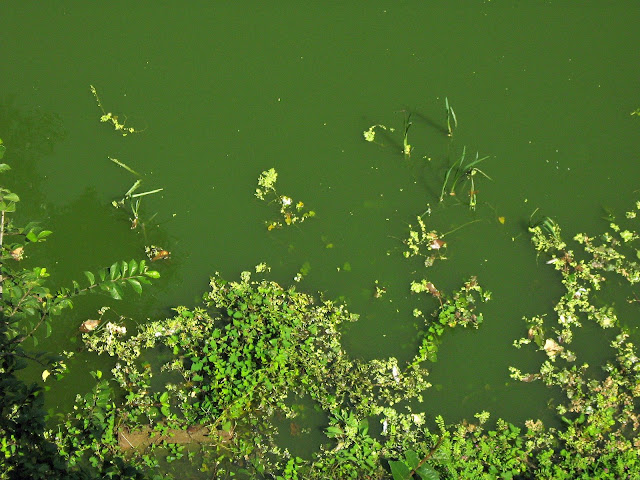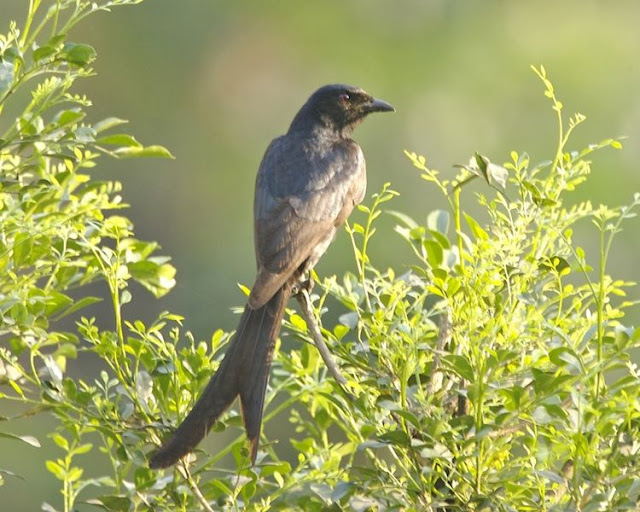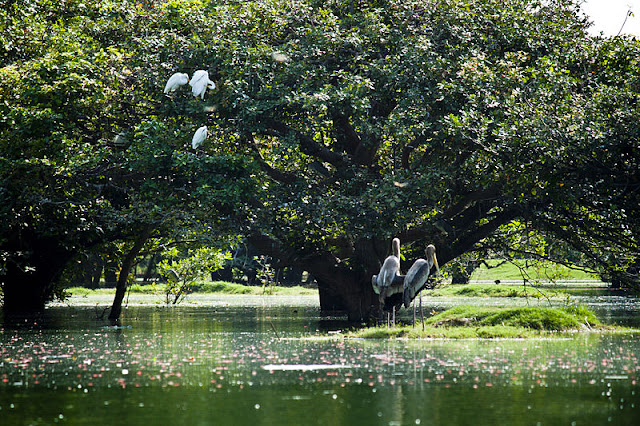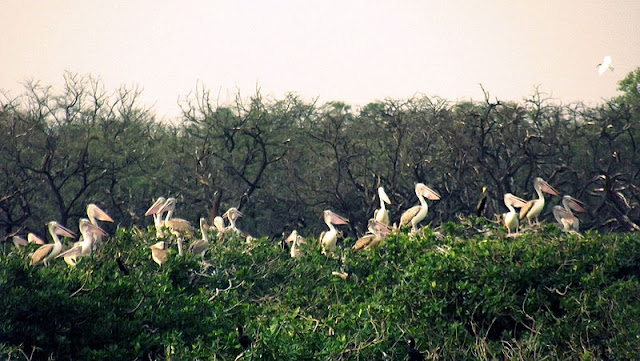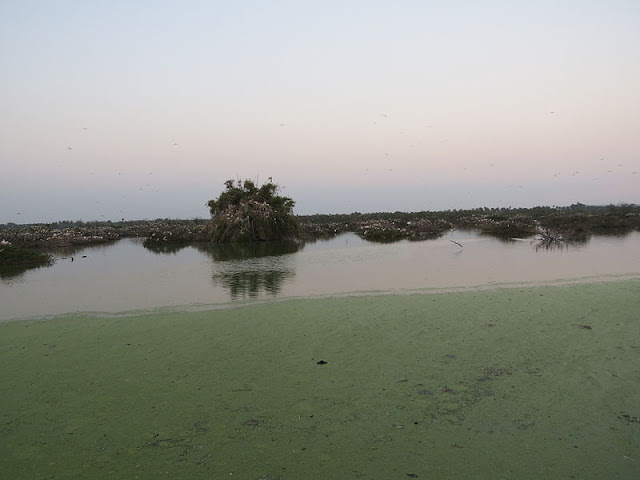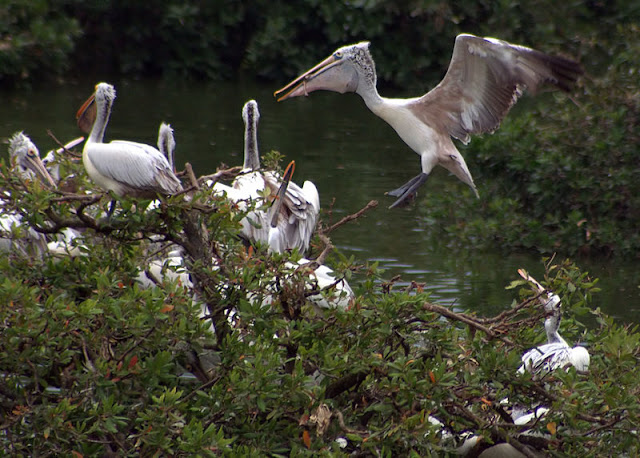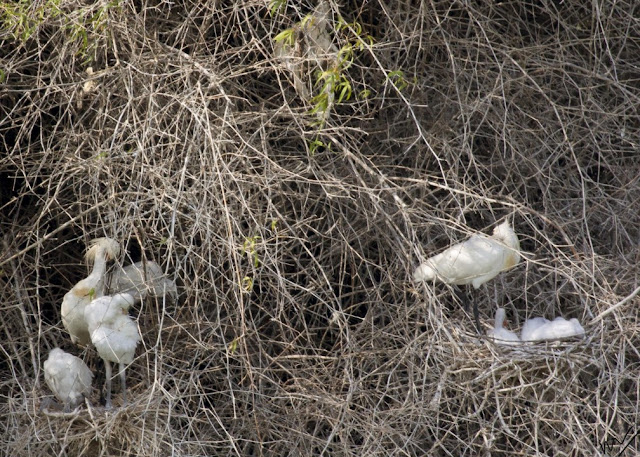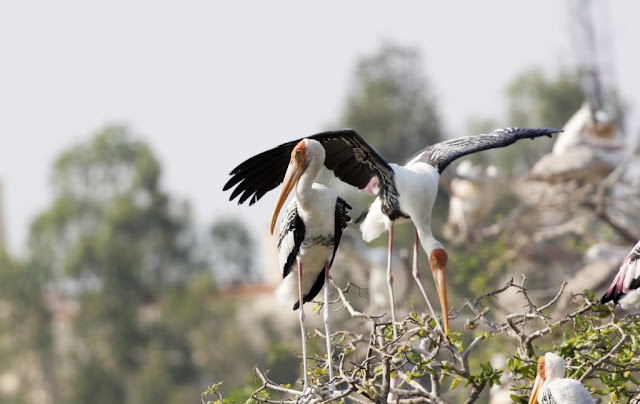Vedanthangal Bird Sanctuary, Chengalpattu
Vedanthangal
Bird Sanctuary is a 30-hectare (74-acre) protected area located in the Kancheepuram District of
the state of Tamil Nadu, India.
The sanctuary is about 75 kilometers (47 mi) from Chennai on
National Highway 45, south of Chengalpattu.
More than 40,000 birds (including 26 rare species), from various parts of the
world visit the sanctuary during the migratory season every year.
Vedanthangal
is home to migratory birds such as pintail, Garganey, grey wagtail, blue-winged teal, common sandpiper and
the like. Vedanthangal is the oldest water bird sanctuary in the
country. Vedanthangal in Tamil language means 'hamlet of the
hunter'. This area was a favourite hunting spot of the local landlords in
the early 18th century. The region attracted a variety of birds because it was
dotted with small lakes that acted as feeding grounds for the birds. Realizing
its ornithological importance, the British government undertook steps to
develop Vedanthangal into a bird sanctuary as early as 1798. This was
established in 1858 by the order of the Collector of Chengalpet.
The
best time to visit this sanctuary is from November to March. During this time,
birds are seen busy building and maintaining their nests.
Villagers
near this sanctuary are very concerned about the sanctuary and its winged
residents, and they have taken many serious steps to avoid disturbance to the
flow of birds. The local people have been protecting the sanctuary for
centuries now because they have realized that the bird droppings falling into
the tank increases nitrogen content of the water and when used to irrigate crop
increases the yield greatly and saves the cost of fertilizers.
As
far back as 1798, the village folk convinced the authorities to give protection
to the birds of the 30 hectares area of the Vedanthangal tank. Around 30000
birds come every season even though the area is just 30 ha It then attracts
multitudes of herons, egrets, storks, ibises and spoon bills. If the monsoon is
heavy, these trees can be partially submerged.
Vedanthangal
Water Birds Sanctuary is a paradise for bird lovers and ornithologists. The
sanctuary gets its name from a village close at hand that has the same name.
Vedanthangal Sanctuary is just 75 km from the city of Chennai, and its
serene environs provide a refreshing retreat from the noise and grime of urban
chaos. The leafy landscape, the lush greenery, the twitter of birds and the
sight of our colorful feathered friends darting about are an instant pick-me-up
for city weary souls! The sanctuary is easily accessible by road and rail as
well as from the Chennai airport. And the Forest Department and Tamil Nadu
Tourism Development Corporation (TTDC) provide decent accommodation for those
who wish to stay over.
Location
|
Kanchipuram District – 86 Km from
Chennai
|
Area
|
30 ha.
|
Annual
Rainfall
|
About 1200 mm
|
Nearest
airport
|
Chennai – 58 Km away
|
Nearest
Railway station
|
Chengalpattu – 30 Km away
|
Accommodation
|
Forest Rest House at Vedanthangal with
catering arrangements, P.W.D. Rest House at Karunguzhi.
|
Other
facilities
|
Regular bus services from Chennai,
Tambaram and Chengalpattu.
|
History
Vedanthangal
Bird Sanctuary is one of the oldest in India and also one of its smallest. The
sanctuary has a fascinating history. The locals have protected this sanctuary
down the ages. The rain fed Vedanthangal Tank’s water has been greatly enriched
by bird droppings as these droppings increase the nitrogen content of the
water. When this water is used to irrigate crops, the yield is significantly
larger and farmers save on the cost of fertilizers.
Interestingly,
as far back as 1798, the local villagers persuaded the authorities to provide
protection to the birds of the Vedanthangal tank. Even though the tank is small
– just 30 ha – it attracts approximately 30,000 birds every season especially
egrets, herons, storks, spoonbills and ibises.
Towards
the end of the 18th century local villagers complained to the collector
of Chengalpet Lionel
Palace, about the British soldiers shooting the
birds. They demanded and obtained a 'Cowle'
from the collector (Mr Place, Collector of Chengalpet 1796-1798) to protect the
birds. In 1936 the collector officially recognized the lake as a sanctuary. In
1962 it was given the legal status of reserved forest under the Madras Forest Act.
Several
accounts of the sanctuary were published in the mid-19th century. In 1936,
the park was notified as a sanctuary,
and in 1962, the Madras Forest Act legally accorded the status of a reserve
forest to Vedanthangal. Ten years later, the place was declared as a wildlife sanctuary.
In
the government order dated 8 July 1988, the area was declared as 'Vedanthangal
Lake Bird Sanctuary', under the Wildlife Protection Act of 1972.
In
1967, a rest house was constructed for the convenience of visiting inspecting
officers and tourists.
The
area had a compact grove of more than 500 Barringtonia trees
earlier. An additional 100 trees were planted in 1973 and over
1,000 trees were planted in 1996.
Location
The
Vedanthangal Lake Birds Sanctuary at 122 m above MSL lies 48 km inland from the
Bay of Bengal in Chengalpet District of Tamil Nadu.
The Lake
The
Vedanthangal Lake is situated 122 m above sea level. It supplies water to
250 acres of agricultural land around the area. The west and south sides of the
lake are bordered by a long bund, whereas the northern and eastern sides extend
to the agricultural lands. Input of water into this lake is through four small
canals. Maximum depth of the lake is 5 metres. The area receives an
average annual rainfall of 10 mm, mostly from the north-east monsoon.
Flora
The
rain fed Vedanthangal tank is dry through much of the summer. An earthen
embankment along its western precincts impounds the water when the tank begins
to fill in August. It does not support permanent water plants. The Barringtonia
trees at the edges and the center of the tank support the nests and are scenes
of hectic activity. Their crowns, looking like leafy green islands in the water
serve as nesting platforms and perch-sites.
Flora:
Barringtonia acutangula, Acacia nilotica, and Alangium
salviflorum trees and dry evergreen scrub and thorn forests.
Fauna
Vedanthangal
Bird Sanctuary is a must visit if you are love nature and birds; the sight of
thousands of graceful birds flapping around is bound to send you into raptures!
The sanctuary is home to a host of aquatic birds and the sight of these charming
winged creatures flitting around in various hues, shapes and sizes is
enchanting to say the least. Ideally, visit this charming sanctuary between
November and January because that is when hordes of migratory birds swoop down
on to its verdant surroundings.
During
summer, the Vedanthangal Tank is quite dry but once the monsoons arrive, the
tank starts filling up. The Barringtonia trees form a lush border at the edges
of the tank and also rise up in the center where they look like leafy emerald
islands bobbing in the water. These trees serve as nesting sites for birds as
well as perching sites.
Vedanthangal
Bird Sanctuary attracts over 1, 00,000 birds so the variety of feathered
friends that you can spot are quite staggering. Occupying pride of place here
are the aquatic birds.
The
Vedanthangal Lake Bird Sanctuary features thousands of birds coming from
various countries, some of which can be easily identified. One of the first
birds to arrive at Vedanthangal are Open billed storks and breed twice during
the same season before leaving the sanctuary. Egrets, Spot billed pelican,
Painted stork, Great cormorant, Indian Cormorant, Darter, Eurasian spoonbill,
Asian open bill, Black-headed Ibis, Grey Heron, Purple Heron, Great Egret are
seen in large numbers.
Some
of the other commonly seen waterfowl are the white ibis, night heron, darter,
pond heron and ducks like Comb duck, pintails, common teals, dabchick, Shoveller,
black-winged stilt, little stilt, red shank, sand piper, ringed plover, curlew
etc., and arboreal birds like parakeets, babblers, mynas, barbets, bee-eater,
rollers, cuckoos anoles, drongos etc., and raptors such as black winged kite,
Brahminy kite, short-toed eagle, pariah kite etc., are seen in Vedanthangal .
Mammals seen here are Jackal, Jungle Cat, Wild Boar, and Black-naped Hare.
List of Fauna
·
Grebes (Podicipedidae)
·
Little grebe (Tachybaptus
ruficollis)
·
Pelicans (Pelecanidae)
·
Spot-billed pelican (Pelecanus
philippensis)
·
Cormorants
(Phalacrocoracidae)
·
Great cormorant (Phalacrocorax
carbo)
·
Darters (Anhingidae)
·
Darter (Anhinga
melanogaster)
·
Herons (Ardeidae)
·
Grey heron (Ardea
cinerea)
·
Intermediate egret (Egretta
intermedia)
·
Little egret (Egretta
garzetta)
·
Indian pond-heron (Ardeola
grayii)
·
Black-crowned
night-heron (Nycticorax nycticorax)
·
Storks (Ciconiidae)
·
Painted stork (Mycteria
leucocephala)
·
Asian open bill (Anastomus
oscitans)
·
Ibises and spoonbills
(Threskiornithidae)
·
Glossy ibis (Plegadis
falcinellus)
·
Eurasian spoonbill (Platalea
leucorodia)
·
Ducks, geese and swans
(Anatidae)
·
Lesser whistling-duck
(Dendrocygna javanica)
·
Northern pintail (Anas
acuta)
·
Stilts and avocets
(Recurvirostridae)
·
Black-winged stilt (Himantopus
himantopus)
·
Terns (Sternidae)
·
Common tern (Sterna
hirundo)
·
Cuckoos (Cuculidae)
·
Common hawk-cuckoo (Cuculus
varius)
·
Typical owls
(Strigidae)
·
Spotted owlet (Athene
brama)
·
Kingfishers
(Alcedinidae)
·
Pied kingfisher (Ceryle
rudis)
·
Cuckoo-shrikes
(Campephagidae)
·
Black-headed
cuckoo-shrike (Coracina melanoptera)
·
Sunbirds
(Nectariniidae)
·
Purple-rumped sunbird
(Leptocoma zeylonica)
Conservation
Several
steps have been taken by the Government of Tamil Nadu to protect the area.
Water channels have been built by the Public Works Department to
facilitate water supply to the sanctuary from neighbouring lakes.
In
2013, two lakh Barringtonia saplings were planted in the sanctuary to allow
birds to nest. The Vedanthangal Lake was also desilted and deepened to hold
more water.
Best Season
The
best time to visit the sanctuary is during the winter seasons that is from the
month of November to March. The temperature is pleasant during this time with
maximum is around 27°C and the minimum being around 16°C. Migratory birds also
fly into the sanctuary during November to December. Season is open throughout
the year.
Contact
Wildlife Warden,
259 Anna Salai, DMS compound,
Teynampet, Chennai 600 006
Phone:
044-24321471
Accommodation
For
accommodation in Vedanthangal, you can either go for the Forest Department Rest
House or Hotel Tamil Nadu of the Tamil Nadu Tourism Development Corporation.
One can make reservation at the Chennai Office.
Connectivity
By
Air:
The
nearest airport to Vedanthangal is Chennai international airport which is
approximately 70 km from the sanctuary.
Chennai
is the nearest and most convenient airport, connected by daily Indian Airlines
flights from Delhi (6:40, 10:15, 16:45 & 19:00), Mumbai (7:05, 9:20, 11:45,
18:10 & 20:30), Bangalore (8:30) and Kolkata (14:30 & 18:10). From here
you can hire taxi to the destination.
By
Train:
The
nearest railway station is Chengalpet Railway Station which is 26 km away from
Vedanthangal.
Delhi
is conveniently connected through the Thirukkural Exp. (6:00, Sat) & T N Sampark
Kranti (7:25, Tue, Thu) while Mumbai through the Madurai Exp. (00:15, Fri)
& Nagercoil Exp. (12:05, Tue, Sat).
Daily
trains running Chennai-Chengalpattu include the Nellai Exp. (21:00),
Kanyakumari Exp. (17:30), Pandian Exp. (21:30), Pearl City Exp. (18:30),
Anantapuri Exp. (19:30) & Rock Fort Exp. (22:30). One can hire taxi from
the station to the sanctuary.
By
Bus:
To
travel by road from Chennai, take the national highway no. 45 to Chengalpattu
and head south towards Padalam junction. A right turn here will lead to the
sanctuary road.
The
sanctuary can also be accessed from other nearby towns of Kanchipuram and Mahabalipuram,
but the road is not very well maintained. State transport buses ply between
Chennai and Chengalpattu, the best option however would be to travel in your
own four wheeler or hire a taxi from Chennai.
There
are many buses running between Vedanthangal and Chengalpet, Kanchipuram,
Chennai and Mahabalipuram. One can choose between a/c and non a/c buses.
Distance by
road: Chengalpet 34 km, Mamallapuram 45 km,
Chennai 82 km. towards the south west and is approached by NH 45




